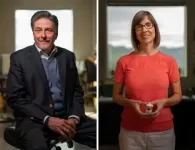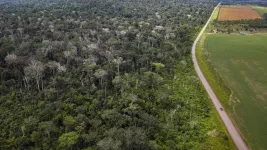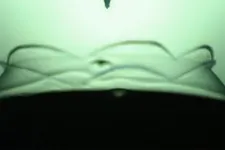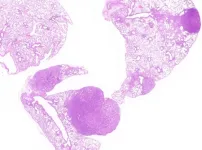INFORMATION:
Co-authors of the paper are Laramie D. Taylor, chair and professor of communication, and Yoo Jung (Erika) Oh, doctoral candidate in the Department of Communication.
Full study is available here:
https://infodemiology.jmir.org/2021/1/e26876
People becoming desensitized to COVID-19 illnesses, death, research suggests
UC Davis study points out need to consider future public health responses
2021-07-19
(Press-News.org) Although people in early 2020 hoarded toilet paper, washed their hands incessantly, and wouldn't leave home, 11 months later the public pushed the envelope on COVID-19 safety precautions and ignored warnings as time went on, a new University of California, Davis, study suggests.
Researchers in the Department of Communication examined people's reactions and expressions of anxiety about news articles on Twitter. Additionally, they investigated reactions to fear-inducing health news over time, despite the steadily rising COVID-19 death toll, said Hannah Stevens, a doctoral student in communication and lead author of the paper.
The paper, "Desensitization to Fear-Inducting COVID-19 Health News on Twitter: Observational Study," was published in the Journal of Medical Internet Research Infodemiology on July 16. The researchers examined how COVID-19 news articles shared to Twitter were first met with anxiety-ridden tweets early in the pandemic, during a coinciding spike in instances of panic-buying, extreme social distancing and quarantine measures. Despite the increased death toll, those behaviors then gave way over time to less concerned responses to COVID-19 news, along with increases in societal risk-taking during that time period.
"COVID-19 has made an indelible mark on history, and now it's time to consider what went wrong so we can do better in communicating more effectively during future health crises, and even now, as the delta variant becomes more widespread," said Stevens. "First and foremost, we need to understand how and why scary health news lost impact over time, despite the rapidly increasing death toll."
The authors set out to test the hypothesis that early fear-based health messages in news reports significantly motivated individuals to take actions to control the threat, yet over-exposure to the same messages desensitized people -- or made them less likely to feel anxious over time.
During a period of 11 months, the team used a computerized methodology to analyze linguistic anxiety levels in hundreds of COVID-19 news articles on Twitter, along with the anxiety levels in corresponding user tweets. They then correlated the findings with the COVID-19 death toll in the United States.
"Our study shows a need to delve deeper into how to re-sensitize the public and motivate them to take action in the face of an ongoing emergency. Testing the effectiveness of various health-risk communication strategies could quite possibly mean the difference between life and death in the future," Stevens said.
"If another health crisis occurred today, or COVID-19 takes another turn for the worse, it is essential for public health officials to consider that they are communicating to a desensitized public. I hope that this paper can be an impetus to get that discussion started."
ELSE PRESS RELEASES FROM THIS DATE:
'Service with a smile' plus tipping leads to sexual harassment for majority of service employees
2021-07-19
Two common practices in the U.S. restaurant industry -- service with a smile and tipping -- contribute to a culture of sexual harassment, according to new research from the University of Notre Dame.
"A perfect storm: Customer sexual harassment as a joint function of financial dependence and emotional labor" was recently published in the Journal of Applied Psychology from Timothy Kundro, assistant professor of management and organization at Notre Dame's Mendoza College of Business.
In the study, co-authored by Alicia Grandey and Vanessa Burke from Penn State University and Gordon Sayre from Emlyon Business School in France, more than 66 percent of restaurant employees reported facing some form of sexual harassment in the past six months.
Previous ...
The climate impact of wild pigs greater than a million cars
2021-07-19
By uprooting carbon trapped in soil, wild pigs are releasing around 4.9 million metric tonnes of carbon dioxide annually across the globe, the equivalent of 1.1 million cars.
An international team led by researchers from The University of Queensland and The University of Canterbury have used predictive population models, coupled with advanced mapping techniques to pinpoint the climate damage wild pigs are causing across five continents.
UQ's Dr Christopher O'Bryan said the globe's ever-expanding population of feral pigs could be a significant threat to the climate.
"Wild pigs are just like tractors ploughing through fields, turning over soil to find food," Dr O'Bryan said.
"When soils are ...
Researchers: HtrA1 augmentation is potential therapy for age-related macular degeneration
2021-07-19
Research conducted at the Sharon Eccles Steele Center for Translational Medicine (SCTM) at the University of Utah's John A. Moran Eye Center explains why people carrying a block of genetic variants strongly associated with the development of age-related macular degeneration (AMD) may develop the disease and identifies a potential therapeutic pathway for slowing or even reversing disease progression.
AMD is a major cause of irreversible blindness worldwide and the leading cause of blindness for Americans aged 55 and over. Following more than 15 years of research that has employed an extensive repository of donated human ocular ...
Global satellite data shows clouds will amplify global heating
2021-07-19
A new approach to analyse satellite measurements of Earth's cloud cover reveals that clouds are very likely to enhance global heating.
The research, by scientists at Imperial College London and the University of East Anglia, is the strongest evidence yet that clouds will amplify global heating over the long term, further exacerbating climate change.
The results, published today in Proceedings of the National Academy of Sciences, also suggest that at double atmospheric carbon dioxide (CO2) concentrations above pre-industrial levels, the climate is unlikely to warm below 2°C, and is more likely on average to warm more than 3°C.
Pre-industrial CO2 levels were around 280 ppm (parts per million), ...
Using archeology to better understand climate change
2021-07-19
Throughout history, people of different cultures and stages of evolution have found ways to adapt, with varying success, to the gradual warming of the environment they live in. But can the past inform the future, now that climate change is happening faster than ever before?
Yes, say an international team of anthropologists, geographers and earth scientists in Canada, the U.S. and France led by Université de Montréal anthropologist Ariane Burke.
In a paper published today in the Proceedings of the National Academy of Sciences, Professor Burke and her colleagues ...
Epicentre of major Amazon droughts and fires saw 2.5 billion trees and vines killed
2021-07-19
A major drought and forest fires in the Amazon rainforest killed billions of trees and plants and turned one of the world's largest carbon sinks into one of its biggest polluters.
Triggered by the 2015-16 El Niño, extreme drought and associated mega-wildfires caused the death of around 2.5 billion trees and plants and emitted 495 million tonnes of CO2 from an area that makes up just 1.2 per cent of the entire Brazilian Amazon rainforest, and 1 per cent of the whole biome.
The stark findings, discovered by an international team of scientists working for more than eight years on a long-term study in the Amazon before, during and after the El Niño, have significant implications for global efforts to control the atmospheric ...
Stanford researchers use high-speed cameras to reveal bubbles popping like blooming flowers
2021-07-19
The oil industry, pharmaceutical companies and bioreactor manufacturers all face one common enemy: bubbles. Bubbles can form during the manufacturing or transport of various liquids, and their formation and rupture can cause significant issues in product quality.
Inspired by these issues and the puzzling physics behind bubbles, an international scientific collaboration was born. Stanford University chemical engineer Gerald Fuller along with his PhD students Aadithya Kannan and Vinny Chandran Suja, as well as visiting PhD student Daniele Tammaro from the University of Naples, teamed up to study how different kinds of bubbles pop.
The researchers were particularly interested in bubbles with proteins embedded on their surfaces, which is a common occurrence in the pharmaceutical industry ...
Seismic surveys have no significant impact on commercially valuable fish in NW Australia
2021-07-19
New research has found marine seismic surveys used in oil and gas exploration are not impacting the abundance or behaviour of commercially valuable fishes in the tropical shelf environment in north-western Australia.
The research is the first of its kind to use dedicated seismic vessels to measure the impacts of the survey's noise in an ocean environment, with the eight-month experiment conducted within a 2500 square kilometre fishery management zone near the Pilbara coast.
It involved using multiple acoustic sensors, tagging 387 red emperor fish and deploying more than ...
CNIO researchers clarify the role of the two isoforms of KRAS, the most common oncogene in humans
2021-07-19
KRAS was one of the first oncogenes to be identified, a few decades ago. It is among the most common drivers of cancer and its mutations can be detected in around 25 per cent of human tumours. The development of KRAS inhibitors is, thus, an extremely active line of research. Effective results have been elusive so far, though - no KRAS inhibitor had been available until a month ago, when the FDA granted approval to Sotorasib.
KRAS encodes two gene products, KRAS4A and KRAS4B, whose levels can vary across organs and embryonic stages. When KRAS mutates, both variants, or isoforms, are activated. Though, some studies have focussed on approaches to target only KRAS4B, since it usually found to be expressed at ...
Program seeks to reduce preventable cancers with free screening, same-day results
2021-07-19
Evidence shows that early detection and treatment of cancer can significantly improve health outcomes, however women in Mississippi, particularly in underserved populations, experience the worst health outcomes for cervical, breast, and oropharyngeal cancer. ...
LAST 30 PRESS RELEASES:
Cardiovascular risk score predicts multiple eye diseases
Health: estimated one in ten British adults used or interested in GLP-1 medications for weight loss
Exercise to treat depression yields similar results to therapy
Whooping cough vaccination for pregnant women strengthens babies’ immune system
Dramatic decline in new cases of orphanhood in Uganda driven by HIV treatment and prevention programs
Stopping weight loss drugs linked to weight regain and reversal of heart health markers
Higher intake of food preservatives linked to increased cancer risk
Mass General Brigham–developed cholera vaccine completes phase 1 trial
First experimental validation of a “150-year-old chemical common sense” direct visualization of the molecular structural changes in the ultrafast anthracene [4+4] photocycloaddition reaction
Lack of support for people on weight loss drugs leaves them vulnerable to nutritional deficiencies, say experts
Dogs’ dinners can have greater climate impact than owners’
Are you ready to swap salmon for sprats and sardines?
1.6 million UK adults used weight loss drugs in past year
American College of Cardiology comments on new dietary guidelines for Americans
American Society of Gene & Cell Therapy and Orphan Therapeutics Accelerator partner to advance and commercialize promising rare disease treatments
One in 14 patients having day case surgery have new or worse chronic pain 3 months after their operation
New study highlights link between eviction rates and gun violence
Heatwaves heat up soil but not toxin levels in rice, study finds
Digital modeling reveals where construction carbon emissions really come from
Turning farm waste into water filters
New study shows how the spleen helps the immune system accept a transplant
New Mayo Clinic study advances personalized prostate cancer education with an EHR-integrated AI agent
Researchers identify novel therapeutic target to improve recovery after nerve injury
Microbes in breast milk help populate infant gut microbiomes
Reprogramming immunity to rewrite the story of Type 1 diabetes
New tool narrows the search for ideal material structures
Artificial saliva containing sugarcane protein helps protect the teeth of patients with head and neck cancer
Understanding the role of linear ubiquitination in T-tubule biogenesis
Researchers identify urban atmosphere as primary reservoir of microplastics
World’s oldest arrow poison – 60,000-year-old traces reveal early advanced hunting techniques
[Press-News.org] People becoming desensitized to COVID-19 illnesses, death, research suggestsUC Davis study points out need to consider future public health responses





